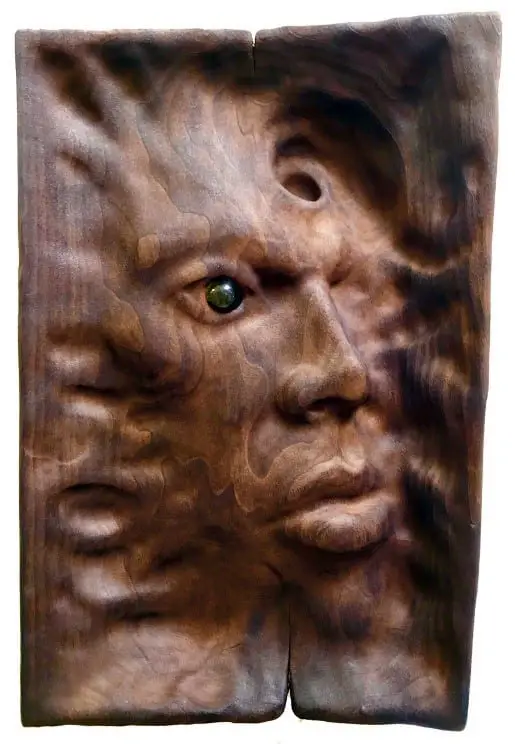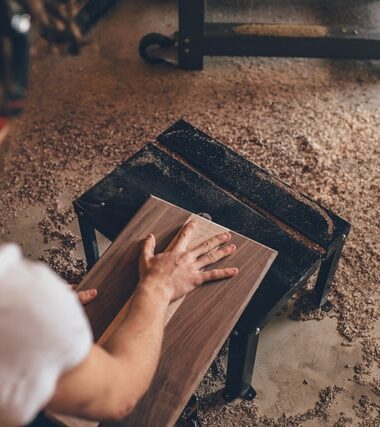The varieties and qualities of both leather and wood can be a vast subject to discuss here. However, in this step-by-step tutorial, there’s no such mention of these topics. Instead, since we will cover most of the relevant procedure without many limitations, we will guide you through the complete process of picking the perfect piece of leather for your furniture.
In this detailed and fun tutorial on how to glue leather to wood, you’re going to learn to do everything on your own with zero to the least effort. So, with no further due, let’s dig in.
What will you need?
- Sandpaper with block
- Wood filler and Applicator
- Cyanoacrylate (CA) glue
- Straight edged Stanley knife
- A soft cloth
- Brush
- Scraper
There are various options to use instead of CA glue, such as contact cement, Polyvinyl Acetate glue and many more. But the best among all is the glue we mentioned above.
Next, we need to prepare our wood piece and leather for the initial stage of glueing them together. This is to be done to complicate the procedure later and let all your hard work go in vain. It’s is vital to follow the overall project guidelines properly for rewarding results.
Step-by-step instructions on how to glue leather on wood
Step 1: Fill holes in wood piece with wood filler and applicator

If you find any uneven holes with large and wide scratches on your wooden piece, then you might need to fill those up first. You can find a decent guide on fixing scratches on wood on cutthewood.com. But, for now, you’re going to need a wood filler and applicator to fill them up and make the surface of your wood regular and symmetrical.
Take your wood filler (which you can find easily find near you) on a scrapper and rub it over the holes and scratches on your wood piece properly. Then, leave it for some time and let it dry entirely.
Don’t worry about the irregular surface after its application because we will take care of it in our next step.
Step 2: Use sandpaper to make it smooth

Cut a portion of sandpaper and place it under a similar-sized block. Then, start rubbing over it and keep rubbing until you get a smooth and flat finish of the wooden surface. Make sure you follow the overall project guidelines carefully.
This is a valuable step in glueing leather to the wood process as it will help the leather glue over the wooden piece more easily and effortlessly.
So keep this in mind and rub the sandpaper until you get satisfaction and a smooth texture from its surface.
Rub a soft cloth over it to clean its surface thoroughly.
Step 3: Trimming of leather

Now it’s time to prepare our leather for the procedure. First, you need to trim it according to the wooden piece you want for a perfect fit.
This is a delicate step because a single mistake can lead to an obscene cut which will ruin the leather and make it unsuitable for the wooden piece you selected. So, follow a separate guide or tips and tricks on cutthewood.com before you begin for more accurate results.
For this step, make sure you have a straight cut and a Stanley knife. It will give you a proper grip and a sharp and even cut. You won’t need to knife one place simultaneously as it will do this job for you at once.
Step 4: Apply glue over the wood

For this step, you need to remember quite a few things.
Our prime concern should be the type of glue we can use to stick them appropriately, which glue will hold up for a long period. Additionally, which glue is best suited for the leather, its drying speed and whether or not it’s waterproof and weather resistant.
Leather is a strong, durable and semi-porous substance that may lead to inconveniences. Therefore, we will need glue that adheres to it without eroding its appearance, which can hold its weight.
Cyanoacrylate (CA), also known as super glue, stands up to all these expectations. It dries up quickly and holds up strongly. In addition, some of them came in gel form, which makes it easier to use, allowing a little more flexibility. This in terms of the fixing period and, on the side hand preventing the accidental run-off.
Apply this glue with the help of a brush on the entire surface suitably. No place should be left off, and the glue layer should not be sturdy.
Step 5: Stick down the leather.

Let’s begin the real task. The leather you trimmed accordingly. Now it’s time to stick it properly on the wood.
You don’t need to rush! Remember, not only can it lead to improper placement, but it will ruin both the leather and wood if once stuck to the wooden piece inappropriately.
You could take help from someone to gently and softly place it on the wooden piece. But if your piece is small, you can easily don’t alone single-handedly.
Keep one thing in mind that after once placed, there’s no taking off. So be concentrated and have patience.
Step 6: The finishing touch

You might be thinking of leaving it for some time as it is to let it dry and be hard and strong. But no, this could be one of your big mistakes because there’s a possibility that air is trapped between the leather and wood.
To let the air out, rub the leather. Use a soft cloth for this task and rub all over it with gentle hands.
Now, let it settle down for a few hours, and you have the all-new classy piece of wood covered with leather.
Precautions
There are several things to remember and some precautions to take to follow up this step-by-step guide.
The first and the most important one is to wear gloves. This will protect your hands from the super adhering glue, which can lead to several complications if it gets stuck to your hand.
The glue we are using is liquid in texture and dries up so quickly, so it will be hard to handle it. It would help if you worked precisely and fast to avoid any mess it can create.
Be careful while working with the knife. Keep your hand, which was not holding up the knife at some distance. This is to keep it safe from any severe injury that can occur due to the sudden slipping of the knife from your hand.
Take help from somebody if you think that this will be hard for you to do alone. A partner can be constructive, indeed.
Rub the leather with a soft cloth only. Please don’t use any harsh fabric as it can damage the leather surface. Also, please don’t use your hands to let the air out of it because you will not be able to configure the amount of pressure it actually needs.
You can use this step-by-step guide on how to glue leather on wood to modify any wooden furniture like tables or chairs and many more. If you follow the overall project guidelines, you can make them look super classy and elegant. So you see, this has vast applications, and you can use it and modify anything at your convenience,
From gifting something to someone or making something for your house or office. You can do anything by learning this skill. You can wake up your inner artist and creator, which will benefit you in many ways.







